My final advice to a student about ITTOs (Before she passed her PMP Test)
Sometimes a student asks me for some specific last-minute advice before they take their PMP Test. To help my readers, I’m going to be sharing notes in this space that I’ve written customized to my students’ questions (before they passed their tests!)
Here is the first of several installments (replying to a student’s question about how to study the ITTOs)
Understanding ITTOs (NOT memorizing them)
About the ITTOs, most PMP experts agree that it’s not necessary to memorize them all. The more you know the better, but it’s more important to understand what they do in each process than to memorize which process they belong to. Also…
OUTPUTS more than the other ITTOs
I always recommend that it’s the outputs that matter most among the ITTOs. The more you understand each output, the more you understand the process it’s an output of. And it’s more likely you’ll be tested on the purpose of a process than on which output belongs to it.
Andy Crow, in his book, which I use in my PMP Prep classes,begins each chapter listing just the key outputs for each process in that Knowledge Area (NOT all the outputs, and NONE of the inputs or tools). So I recommend paying extra attention to each of those 10 pages in his book (The PMP Exam: How To Pass On Your First Try (6th Ed.)
The Outputs That Make Up The Project Management Plan
It’s also key to know which outputs are officially SUB-COMPONENTS of the project management plan. I emphasize in the class how Andy Crowe‘s page that shows you the 18 outputs making up the PM Plan (P. 80, Andy Crowe), e.g.
- Scope management plan
- Schedule management plan
- Risk management plan
- Procurement management plan (and 14 more)
Study The “Trickier” Outputs, e.g.
- VERIFIED DELIVERABLES are the output of the Control Quality process.
- Then they become the input to the “Validate Scope” process.
- Then, the output from Validate Scope is the ACCEPTED DELIVERABLES.
- And BOTH processes use the tool of INSPECTION to create those 2 different outputs.
“Out of Order” Processes
The above is a tough one because the Control Quality process is performed before the Validate Scope process, even though that’s not sequential by the order of the 10 knowledge areas.
I do suggest you give yourself time to work on practice questions. If nothing else, the more questions you do, the faster you get at answering the questions (without going overboard and getting tired of answering questions). But also you can jot down lessons learned from some of the questions.
$40 Discount On The PMP Exam Simulator From OSP Int’l
Once you’ve learned the material well, it’s also important to do a lot of practice questions. The tool I recommend the most is The PMP Exam Simulator from OSP Int’l where you can use my Gift Code as an OSP Affiliate to get the $40 discount
- 1,600 Questions
- Continuously updated by expert staff of PMPs / CSMs / PMI-ACPs
- Expert Rationales provided on all 4 choices on all questions
Gift Code for $40 off: jf-pmpsim6
My Book: The Project Management Answer Book, 2nd Edition
- Five Star Average Review on Amazon (38 Reviews)
- Easy-To-Read Q&A Style
- Liked by readers in 66 countries so far!
- Filled with test tips in Call-Out Boxes
- Many proven test tips, diagrams, figures
Any questions let me know. And all the best. And I look forward to hearing when you get your PMP. Best, Jeff


Leave A Comment